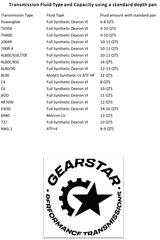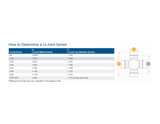An Overview of The Different Levels of An Upgraded Transmission
A high-performance transmission is essential to any vehicle designed to deliver top-notch performance. The transmission transfers power from the engine to the wheels, accelerating the vehicle smoothly and efficiently. Without a high-performance transmission, a vehicle's engine power may not be effectively transmitted to the wheels, resulting in sluggish acceleration, reduced fuel efficiency, and increased wear and tear on the engine. Many car owners seek to upgrade their transmissions to achieve optimal performance. This article will provide an overview of the different levels of upgraded transmission, explaining each level's benefits and helping readers choose the right upgrade level for their vehicle.
Upgraded Transmission: Level 2
Level 2 upgrades build upon the foundation set by Level 1 upgrades, offering more significant enhancements to a vehicle's transmission. These upgrades typically involve adding stronger gears or a performance shift kit to increase the transmission's power-handling capacity and improve shifting speed and accuracy. Upgrading the transmission cooler is another ordinary Level 2 upgrade, as it helps to keep the transmission operating at a safe temperature, particularly in high-stress driving situations.
One of the main benefits of Level 2 upgrades is improved performance and durability under more demanding conditions. By adding stronger gears or a performance shift kit, drivers can push their vehicle's transmission to its limits without fear of failure or excessive wear and tear. Upgrading the transmission cooler can help to prevent overheating and fluid breakdown, ensuring the transmission operates reliably even in extreme heat or high-stress driving situations.
For example, adding a performance shift kit to a Chevrolet Corvette can help to improve the car's acceleration and responsiveness, making it a more engaging and fun driving experience. Similarly, upgrading the transmission cooler on a Jeep Wrangler can help to prevent overheating when off-roading in hot and dusty environments. Regardless of the vehicle, Level 2 upgrades can provide significant performance, durability, and reliability benefits. Standard vehicles that can benefit from Level 2 upgrades include high-performance sports cars, off-road vehicles, and vehicles for racing or towing heavy loads.
Upgraded Transmission: Level 3
Level 3 upgrades represent the highest transmission upgrades, providing the most significant enhancements to a vehicle's performance and power-handling capabilities. These upgrades typically involve heavy-duty components like billet shafts, servos, or sprags, which can withstand much higher levels of torque and power than the stock components. Custom tuning is also often necessary to optimize the performance of the upgraded transmission.
One of the main benefits of Level 3 upgrades is the ability to handle extremely high levels of power and torque, making them ideal for high-performance vehicles, drag racing, or other extreme driving situations. Level 3 upgrades can also improve shift speed and accuracy, providing a more engaging and precise driving experience. With heavy-duty components and custom tuning, drivers can unleash the full potential of their engines without fear of transmission failure or damage.
Typical vehicles that can benefit from Level 3 upgrades include high-performance sports cars, drag racing vehicles, and trucks used for towing or heavy hauling. For example, upgrading the transmission in a Ford Mustang GT with heavy-duty billet components and custom tuning can help the car handle much higher levels of power and torque, resulting in improved acceleration and top speed. Similarly, upgrading the transmission in a Dodge Ram truck used for towing heavy loads can help to prevent transmission failure and ensure reliable performance under extreme stress.
Level 3 upgrades represent the highest transmission upgrades, providing significant benefits in power handling, durability, and performance. These upgrades are typically reserved for high-performance vehicles or those used in extreme driving situations and require heavy-duty components and custom tuning to optimize their performance.
Upgraded Transmission: Level 4
Level 4 upgrades are the most comprehensive and extensive modifications that can be made to a transmission. These upgrades involve a complete overhaul of the transmission with high-performance components and custom tuning to optimize the performance of the upgraded transmission. Level 4 upgrades are typically reserved for extreme driving situations or high-performance racing vehicles, where maximum power and performance are required.
The benefits of Level 4 upgrade transmissions are significant, providing the highest power handling and performance available. The upgraded transmission can also improve shift speed, accuracy, and response time, resulting in a more engaging and precise driving experience. With a complete overhaul and high-performance components, drivers can unleash the full potential of their engines without fear of transmission failure or damage.
Standard vehicles that can benefit from Level 4 upgrades include high-performance racing vehicles, off-road trucks used for extreme driving, and vehicles used for professional motorsports. For example, upgrading the transmission in a drag racing car with a complete overhaul and high-performance components can provide unmatched power handling capabilities, resulting in faster acceleration and higher top speeds. Similarly, upgrading the transmission in an off-road truck used for extreme rock crawling or mudding can provide the durability and power necessary to navigate rugged terrain without damaging the transmission.
Level 4 upgrades represent the highest level of transmission upgrades, providing the most extensive modifications available for extreme power and performance. These upgrades are typically reserved for extreme driving situations or high-performance racing vehicles. They require a complete transmission overhaul with high-performance components and custom tuning to optimize performance.
Choosing the Right Upgrade Level
Choosing the right level of transmission upgrade for your vehicle can be challenging. It would be best if you considered several factors when deciding which level of upgrade is suitable for your vehicle, such as your budget, driving habits, and plans for your vehicle.
Your budget is one of the most important factors when choosing a transmission upgrade. Upgrades can range in price from a few hundred dollars to several thousand dollars, depending on the level of upgrade and the specific components being used. Setting and sticking to a budget to avoid overspending or unnecessary upgrades is essential.
Your driving habits are also an essential consideration when choosing a transmission upgrade. If you use your vehicle for daily commuting or light-duty driving, a Level 1 or Level 2 upgrade may be sufficient to meet your needs. However, suppose you frequently tow heavy loads or participate in extreme driving situations. A Level 3 or Level 4 upgrade may be necessary to ensure your transmission can handle the additional power and stress.
Finally, it's essential to consider your plans for your vehicle. Plan to keep your vehicle for an extended period or participate in professional motorsports. A Level 3 or Level 4 upgrade may be the best choice for maximum durability and performance. However, if you plan to sell or trade-in your vehicle shortly, a Level 1 or Level 2 upgrade may be sufficient to improve its performance and value.
Choosing the right level of transmission upgrade for your vehicle requires careful consideration of several factors, including your budget, driving habits, and plans for your vehicle. By assessing your needs and choosing the appropriate upgrade level, you can improve your vehicle's performance and durability while avoiding overspending or unnecessary upgrades.
Conclusion
Upgrading the transmission can significantly enhance the overall performance of a vehicle. With the right upgrade, you can experience smoother shifting, enhanced acceleration, and improved transmission durability. Each upgrade level provides distinct benefits, from replacing worn-out components in Level 1 to comprehensive overhauls with high-performance parts in Level 4. When deciding on the appropriate upgrade level, it is essential to consider various factors such as driving habits, budget, and plans for the vehicle. We strongly recommend exploring all the available options and consulting with a professional to determine the optimal upgrade for your specific requirements.



